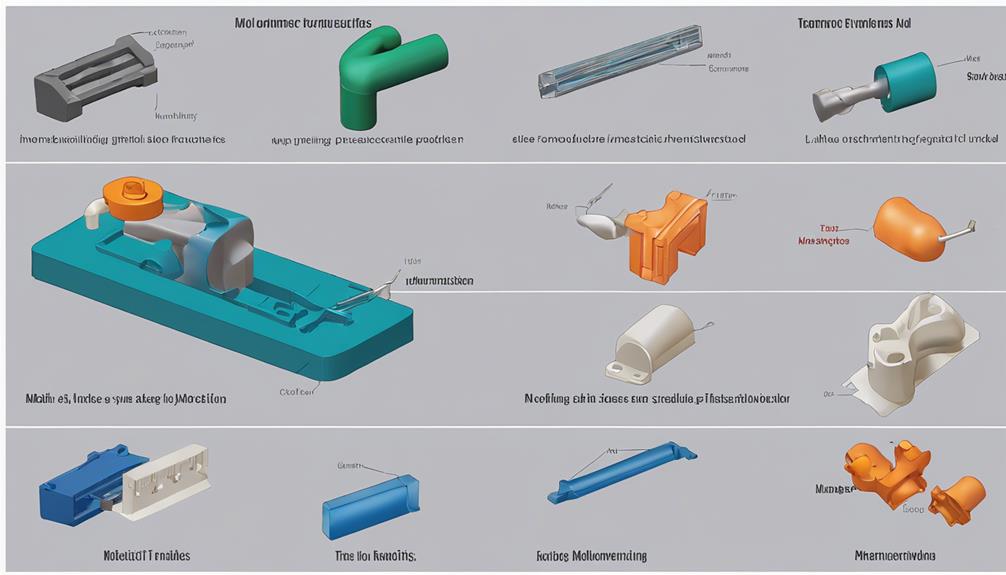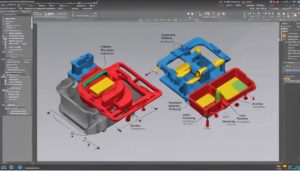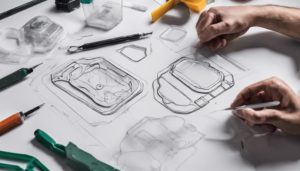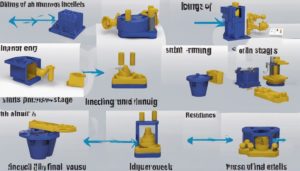Explore diverse injection molding processes such as plastic, rubber, metal, and reaction molding that cater to intricate manufacturing needs. Hot runner molding provides precise control, while cold runner molding optimizes resource use. Gas-assisted injection molding reduces weight and sink marks, benefiting automotive and consumer industries. Water-assisted injection molding achieves complex geometries efficiently. Multi-material/multi-shot molding enhances performance and design options. Insert molding strategically combines components for optimized efficiency. These methods offer a glimpse into the vast world of injection molding techniques, each tailored to specific industry requirements.
Plastic Injection Molding
Plastic injection molding, a highly efficient process in the manufacturing industry, involves the precise melting and injection of plastic resin pellets into molds to create intricate and customizable components at high volumes. This process is ideal for producing plastic parts with complex geometries and varying sizes. The versatility of plastic injection molding allows for the use of a wide range of plastic materials, including thermoplastics and thermosetting polymers. By adjusting the material composition, additives, and colors, manufacturers can achieve specific properties such as strength, flexibility, or heat resistance in the final parts.
The plastic injection molding process begins with the heating of the plastic resin pellets to a molten state. The molten material is then injected into the mold cavity under high pressure, where it cools and solidifies to form the desired shape. This method guarantees consistent and repeatable production of high-quality plastic parts, making it a cost-effective solution for mass production in industries like automotive, consumer goods, electronics, and medical devices.
Rubber Injection Molding
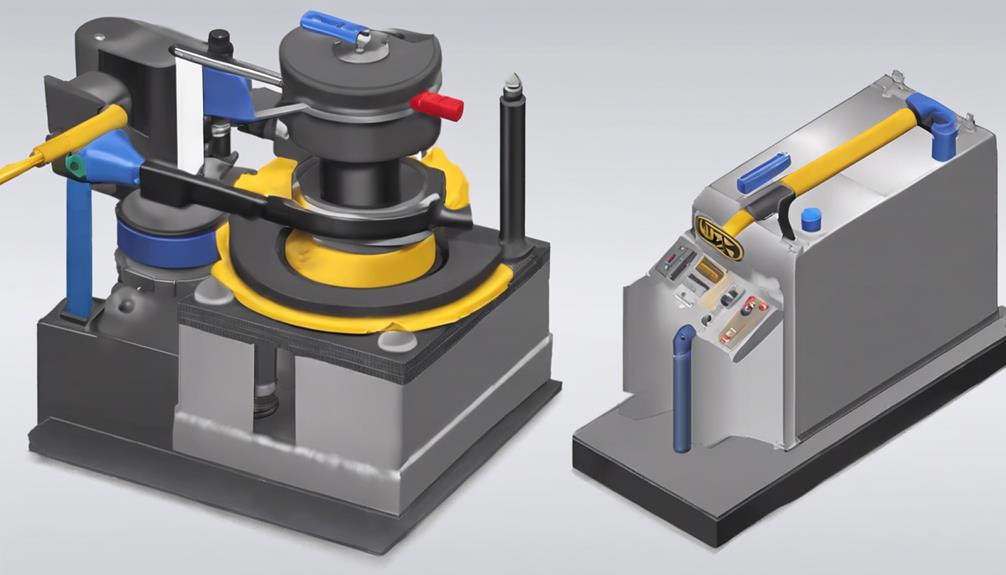
Utilizing a specialized technique for manufacturing precise rubber components at high volumes, rubber injection molding is a process that involves injecting liquid rubber material into molds to create intricate shapes and designs. This method is commonly used in industries such as automotive, aerospace, and medical, where flexibility and durability are essential.
Here are some key points about rubber injection molding:
- Precision: The process allows for the creation of complex shapes with tight tolerances, ensuring the production of high-quality rubber parts.
- Efficiency: With the capability for high volume production, rubber injection molding is an efficient method for manufacturing custom rubber components in large quantities.
- Quality: Rubber injection molding offers consistent quality and performance in the final products, with excellent surface finishes that meet industry standards.
Metal Injection Molding
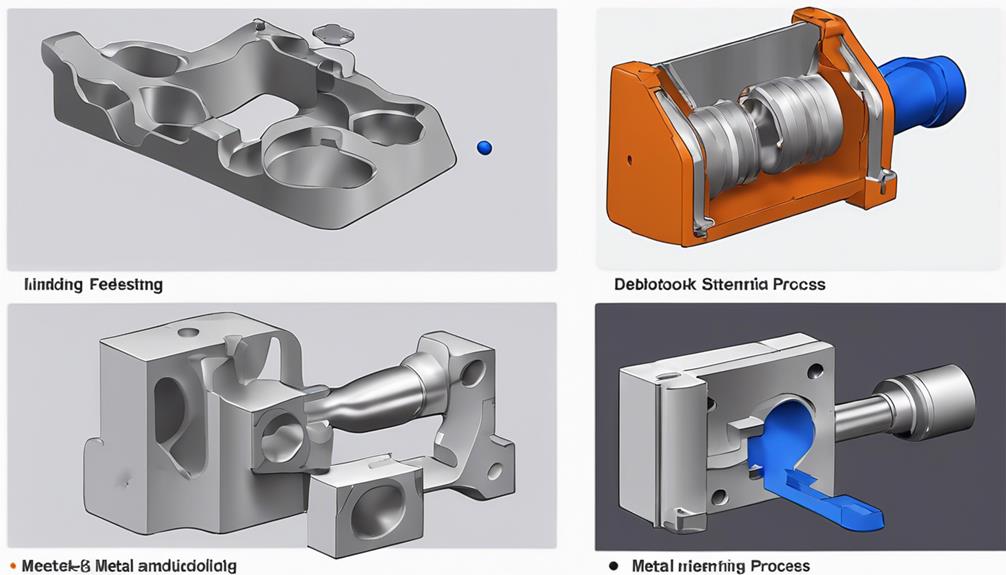
How does metal injection molding combine the versatility of plastic injection molding with the strength and durability of metal materials?
Metal injection molding (MIM) achieves this combination by utilizing metal powders mixed with a binding agent to create a feedstock suitable for the injection molding process. The metal feedstock is injected into a mold cavity to form the desired part. After molding, the component undergoes a debinding process to remove the binding agent, leaving behind the metal powder compact. The debinded part is then sintered in a controlled atmosphere to fuse the metal particles together, resulting in a fully dense metal component with the required mechanical properties.
MIM is a cost-effective manufacturing method suitable for producing complex metal parts with high precision and tight tolerances. This process finds applications across various industries such as automotive, aerospace, medical, and consumer electronics, where intricate metal components are required for different applications. The versatility and efficiency of metal injection molding make it a preferred choice for producing small to medium-sized metal parts with intricate geometries and excellent surface finish.
Reaction Injection Molding
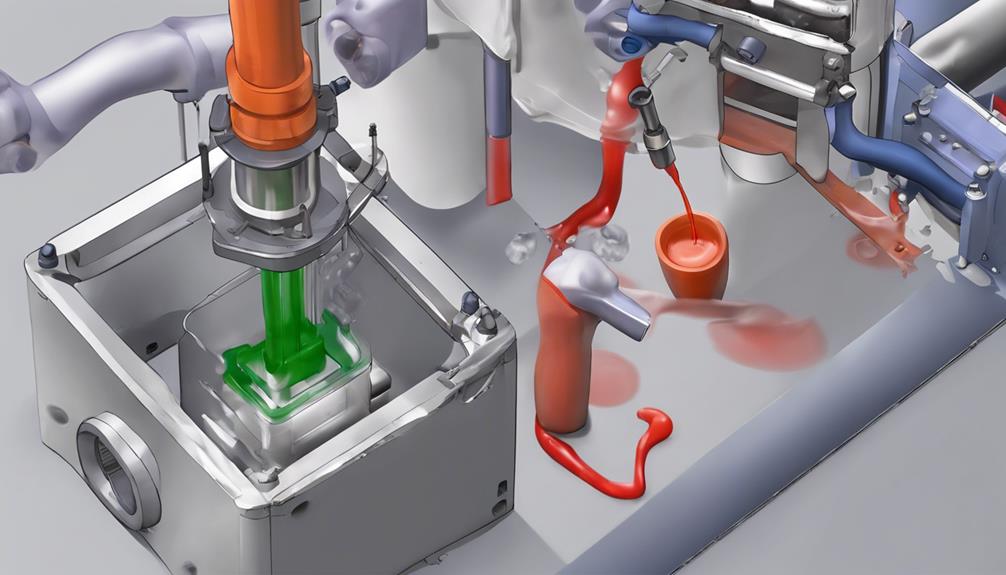
Reaction Injection Molding (RIM) involves the precise mixing of polyols and isocyanates to create polyurethane parts.
This process facilitates the production of lightweight, intricate parts with superior surface quality and strength.
RIM is particularly advantageous for applications requiring high strength-to-weight ratios, such as automotive components and medical equipment.
Material Mixing Process
The material mixing process in Reaction Injection Molding (RIM) involves the precise injection of liquid components into a closed mold to initiate a chemical reaction, resulting in the formation of polyurethane parts. This process offers numerous advantages, such as:
- Enhanced Durability: Polyurethane parts produced through RIM are known for their durability and impact resistance, making them ideal for various industries.
- Versatile Design Options: RIM allows for intricate designs and varying durometers, enabling the production of complex parts with precision.
- High-Quality Surface Finishes: The material mixing process in RIM guarantees high-quality surface finishes on molded parts, meeting stringent quality standards.
These factors make RIM a preferred choice for manufacturing durable, high-quality components for applications in automotive, furniture, and appliance industries.
Curing and Molding
Upon infusion and reaction of liquid components, the Curing and Molding process in Reaction Injection Molding (RIM) initiates the formation of polyurethane parts with exceptional strength and dimensional accuracy.
RIM, known for its fast curing times, facilitates rapid part production compared to conventional molding techniques. The chemical reaction taking place during RIM not only guarantees quick curing but also results in parts with high strength-to-weight ratios and superior impact resistance.
This molding method is particularly suitable for producing large, intricate parts with varying wall thicknesses. Additionally, RIM-produced parts exhibit remarkable dimensional stability and can be tailored with a wide range of finishes and textures, making them versatile for diverse applications.
Hot Runner Molding
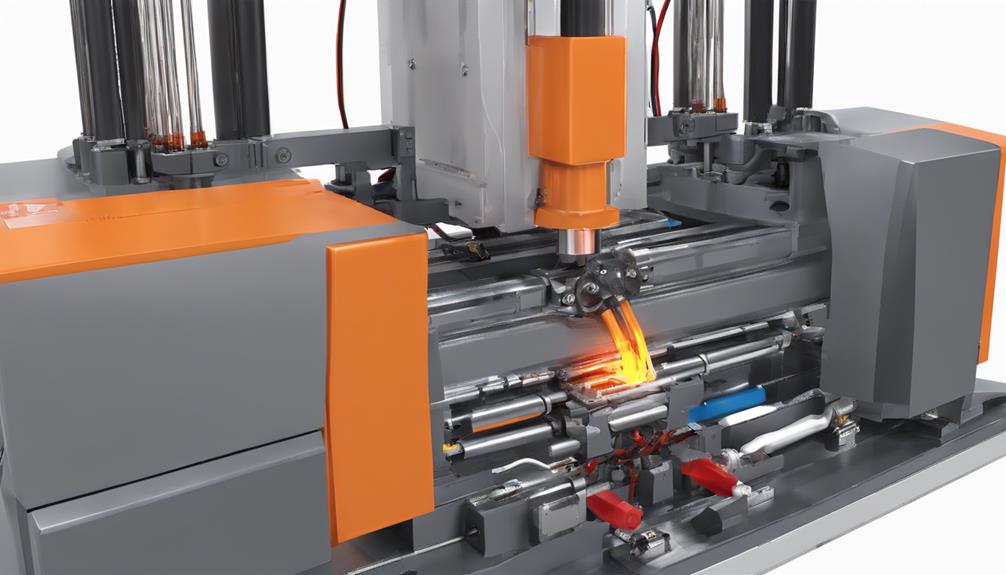
Utilizing advanced heated channels, hot runner molding is a cutting-edge injection molding technique that enables precise control over the flow of plastic material to enhance efficiency and quality in part production.
Hot runner systems play an important role in the injection molding process, offering numerous advantages such as reduced material waste, improved efficiency, and enhanced part quality. To guarantee peak performance, hot runner systems require regular maintenance and calibration.
Additionally, the design flexibility provided by hot runner molding allows for intricate and complex part geometries, making it a preferred choice in industries requiring high precision components. Furthermore, the elimination of sprues and runners not only reduces production costs but also minimizes the environmental impact, making hot runner molding a sustainable option for manufacturers looking to streamline their operations.
Cold Runner Molding
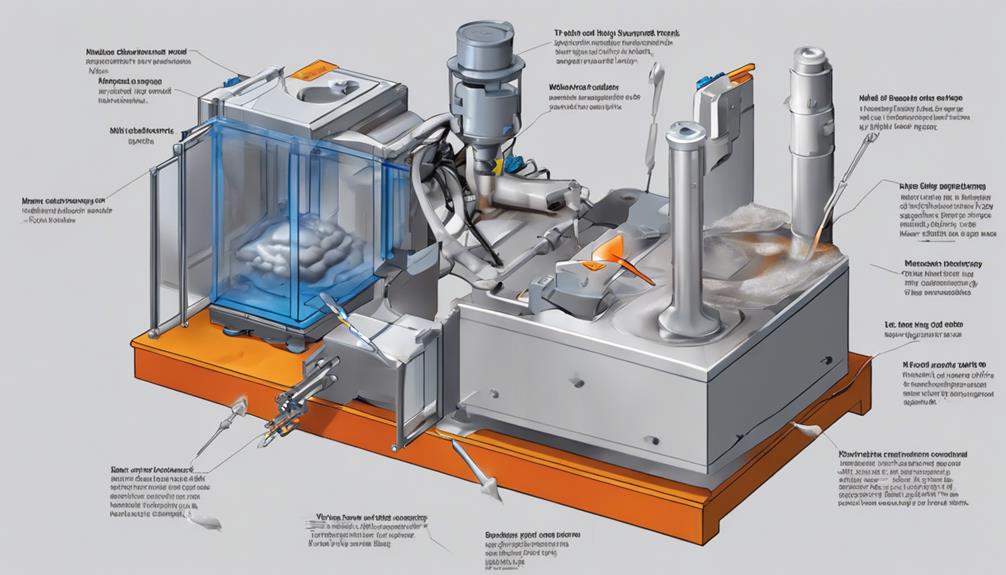
Cold runner molding is an integral part of injection molding processes. It focuses on efficient material usage and waste minimization. By employing a separate runner system, this method optimizes material flow to mold cavities, making it ideal for industries that require cost-effective solutions.
Its versatility with various thermoplastic materials allows for enhanced production capabilities while ensuring consistent part quality and reduced cycle times.
Efficient Material Usage
Efficiently optimizing material usage in injection molding processes is essential for minimizing waste and enhancing resource utilization. Cold runner molding plays a significant role in achieving these goals by effectively managing material flow and minimizing scrap generation.
Here are three key benefits of efficient material usage in cold runner molding:
- Cost Savings: By reusing excess plastic from the runner system, cold runner molding helps reduce material waste, ultimately leading to cost savings in production.
- Environmental Benefits: The efficient utilization of materials in cold runner molding not only reduces waste but also contributes to environmental sustainability by minimizing the impact on landfills.
- Resource Optimization: Cold runner molding guarantees precise distribution of material to mold cavities, optimizing resource utilization and enhancing overall production efficiency.
Minimizing Waste Products
Minimizing waste products in cold runner molding involves strategic management of material flow to optimize resource utilization and reduce excess material generation. Cold runner molding, a cost-effective injection molding process, utilizes a runner system that remains at room temperature, greatly reducing material wastage compared to hot runner molding.
This method is favored in industries prioritizing material efficiency such as consumer goods, automotive, and electronics. The cold runner system efficiently directs the molten plastic to the cavities, ensuring smooth entry and minimizing excess material.
Manufacturers can further enhance the process by optimizing the design and layout of the cold runner system, leading to significant waste reduction and improved overall efficiency in the injection molding process.
Gas-assisted Injection Molding
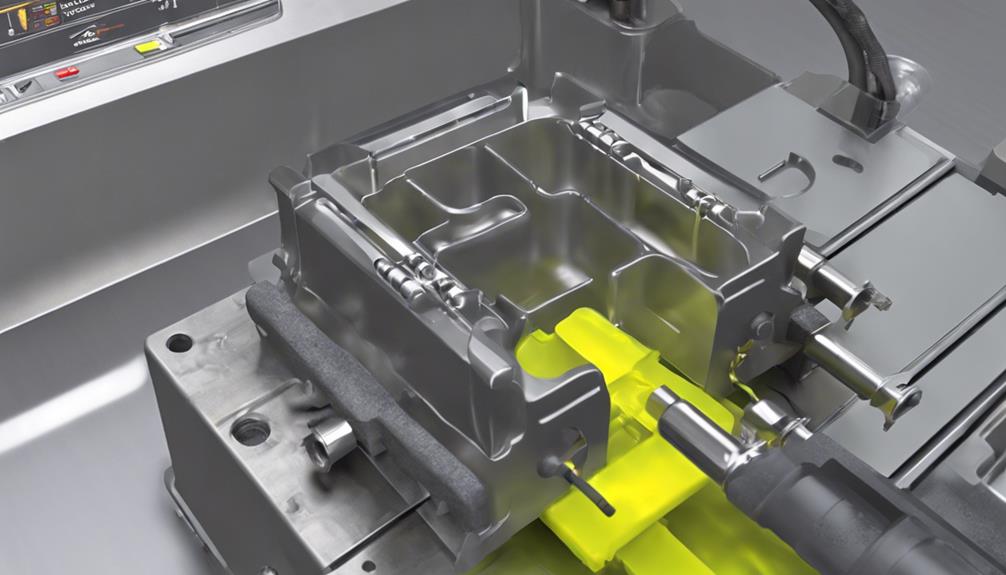
Gas-assisted injection molding is a manufacturing process that leverages compressed gas to create intricate geometries and hollow sections within plastic parts. This method offers several advantages that make it a preferred choice in various industries:
- Reduced Part Weight: By utilizing gas to hollow out sections of the part, the overall weight of the component is decreased, making it more lightweight and cost-effective.
- Improved Surface Finish: The use of gas in the molding process helps in achieving a smooth and uniform surface finish on the plastic parts, enhancing their aesthetic appeal.
- Minimized Sink Marks: Gas-assisted injection molding reduces the occurrence of sink marks, which are depressions on the part's surface caused by uneven cooling, resulting in a visually unattractive final product.
This technology allows for the production of complex parts with controlled internal pressure, enabling the creation of lightweight yet structurally robust components. Industries such as automotive, furniture, and consumer goods benefit from gas-assisted injection molding due to its ability to produce high-quality plastic parts efficiently.
Water-assisted Injection Molding
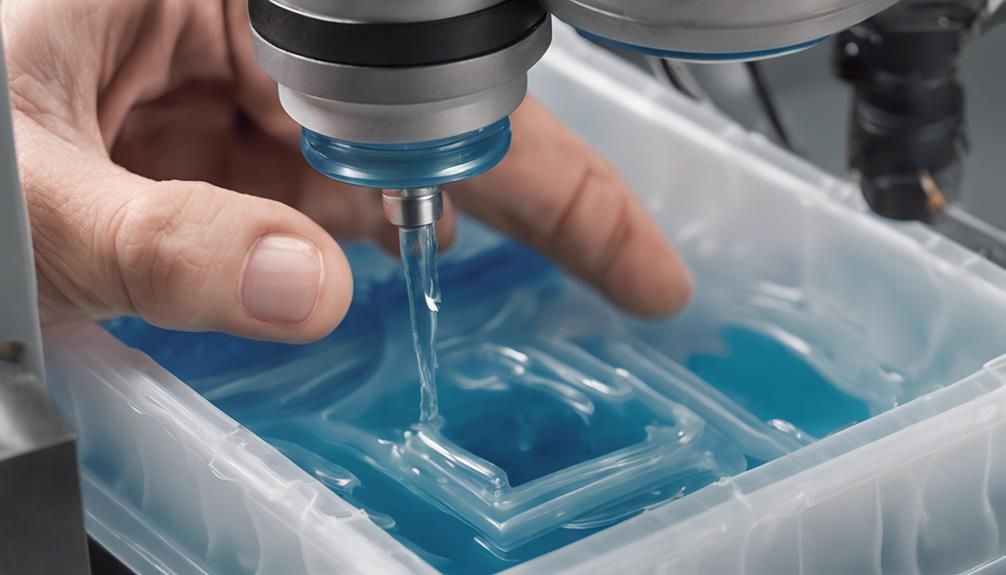
Utilizing high-pressure water to achieve intricate hollow sections and complex geometries in plastic parts, water-assisted injection molding (WAIM) is a versatile manufacturing process with significant benefits across various industries. WAIM reduces material usage by displacing plastic with water during the molding process, resulting in lightweight components. This innovative technique not only creates hollow sections within parts but also enhances part quality by minimizing sink marks, reducing residual stresses, and improving surface finish.
The ability of WAIM to produce complex geometries with precision makes it suitable for a wide range of industries, including automotive, consumer goods, and medical devices. By integrating water into the injection molding process, WAIM offers cost-efficient solutions for manufacturing intricate plastic parts with structural integrity. The process of using high-pressure water in injection molding provides manufacturers with a reliable method to achieve intricate designs while ensuring the durability and quality of the final products.
Multi-material/Multi-shot Molding
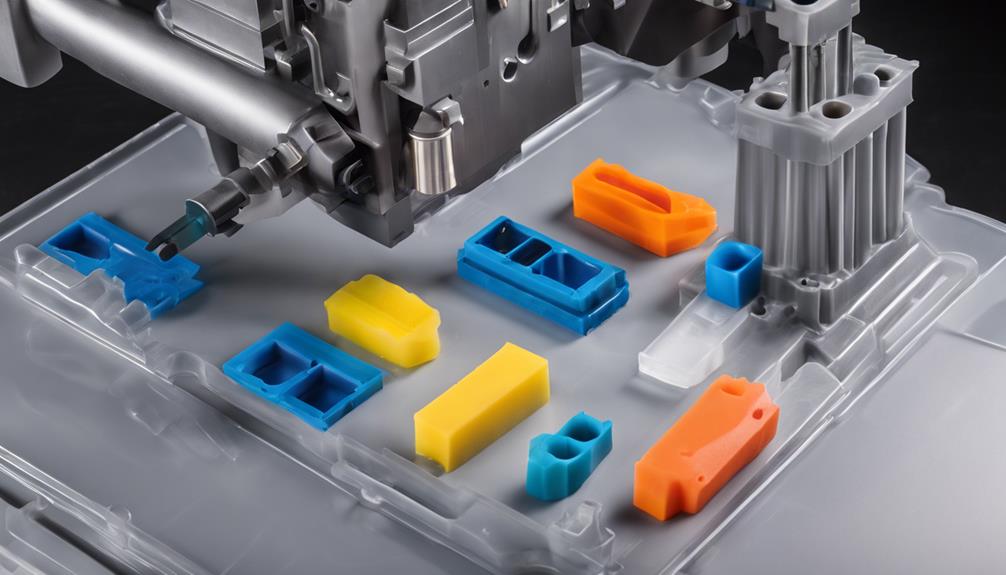
Multi-material/multi-shot molding, a sophisticated injection molding technique, enables the production of parts incorporating two or more distinct materials or colors within a single manufacturing cycle. This process enhances product functionality and aesthetics by combining various materials for specific performance requirements. Here are three compelling reasons why multi-material/multi-shot molding is a valuable technique in the manufacturing industry:
- Enhanced Product Performance: By utilizing different materials in a single part, manufacturers can create components with superior mechanical properties, such as increased strength or flexibility, leading to enhanced overall product performance.
- Cost Efficiency: Integrating multiple materials into a single part during the molding process reduces the need for additional assembly steps, resulting in cost savings for manufacturers.
- Versatile Design Options: This method allows for the creation of complex part designs with multiple colors or materials, offering designers greater flexibility in product development.
Multi-material/multi-shot molding is widely adopted in industries like automotive, electronics, and consumer goods to achieve intricate part designs efficiently and economically.
Insert Molding
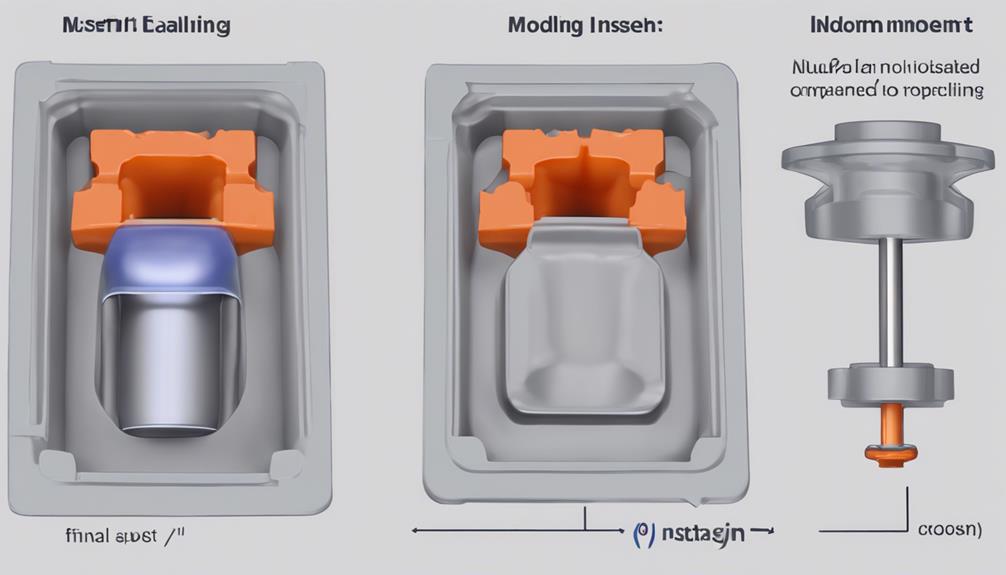
Insert molding offers a strategic advantage in molding operations by combining pre-formed components with molten thermoplastic material.
Mold design considerations and material selection play critical roles in achieving successful insert molding processes.
Understanding these key points is essential for optimizing production efficiency and product quality in various industries' applications.
Mold Design Considerations
When designing molds for insert molding processes, thoughtful consideration of the component integration and material compatibility is essential to guarantee the production of high-quality integrated parts. In the domain of insert molding, the following key mold design considerations play a vital role:
- Precision Alignment: Ensuring precise alignment of the pre-formed components within the mold cavity is paramount for achieving accurate placement and best part functionality.
- Optimized Cooling Channels: Efficient cooling channel design helps in maintaining consistent part quality, reducing cycle times, and enhancing overall productivity.
- Venting Systems: Proper venting mechanisms are indispensable to prevent trapped air or gases during the molding process, thereby ensuring defect-free integrated parts.
Material Selection Tips
In the domain of insert molding processes, a cautious approach to material selection is vital to guarantee excellent adhesion, performance, and longevity of the integrated parts.
When selecting a material for insert molding, it is essential to take into account its compatibility with the insert material to make sure of proper adhesion and performance. The thermal properties of the chosen material should match to prevent distortion or damage during the molding process.
Additionally, the material's mechanical strength and rigidity must meet the requirements of the final part design to secure structural integrity. Furthermore, the chemical resistance of the material plays a significant role in ensuring the durability and longevity of the insert molded part.
Considering surface finish and texture is also important to achieve the desired aesthetics and functionality of the insert molded product.
Blow Molding
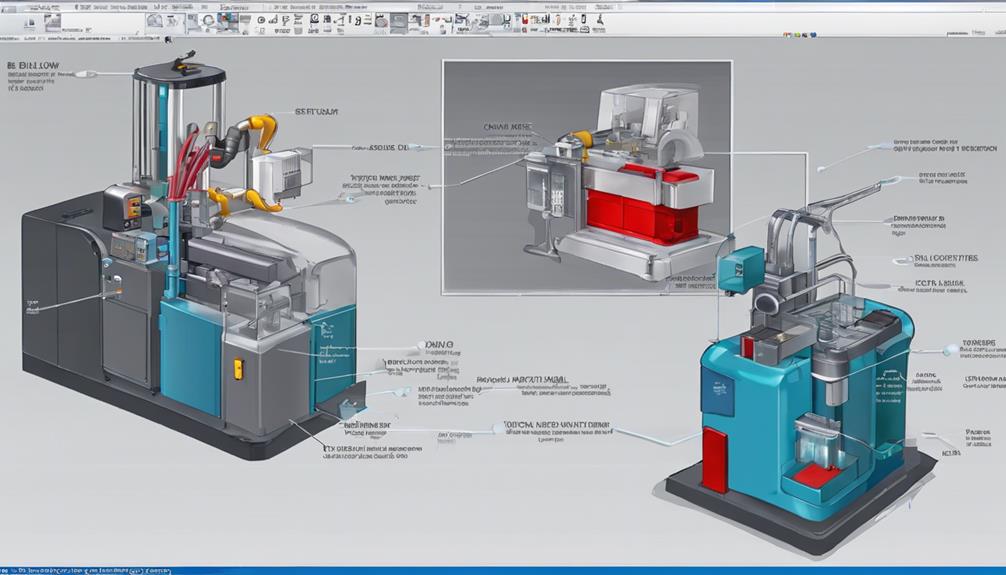
Blow molding, a plastic manufacturing process utilized for creating hollow objects such as bottles and containers, involves heating a plastic parison and then inflating it with compressed air to conform to the shape of the mold. There are two main types of blow molding techniques:
- Extrusion Blow Molding: In this method, a plastic parison is extruded through a die and clamped into a mold. The parison is then inflated to the desired shape using compressed air. This process is commonly used for producing items like milk jugs, shampoo bottles, and automotive ducts.
- Injection Blow Molding: This process combines injection molding and blow molding. A molten tube is injected into a preform mold to create a hollow shape. The preform is then transferred to a blow mold where it is inflated. Injection blow molding is often chosen for high-precision applications such as medical containers and small bottles.
Blow molding is a cost-effective solution for mass-producing uniform and lightweight hollow plastic products, making it a popular choice across various industries like packaging, automotive, and consumer goods.
Extrusion Molding
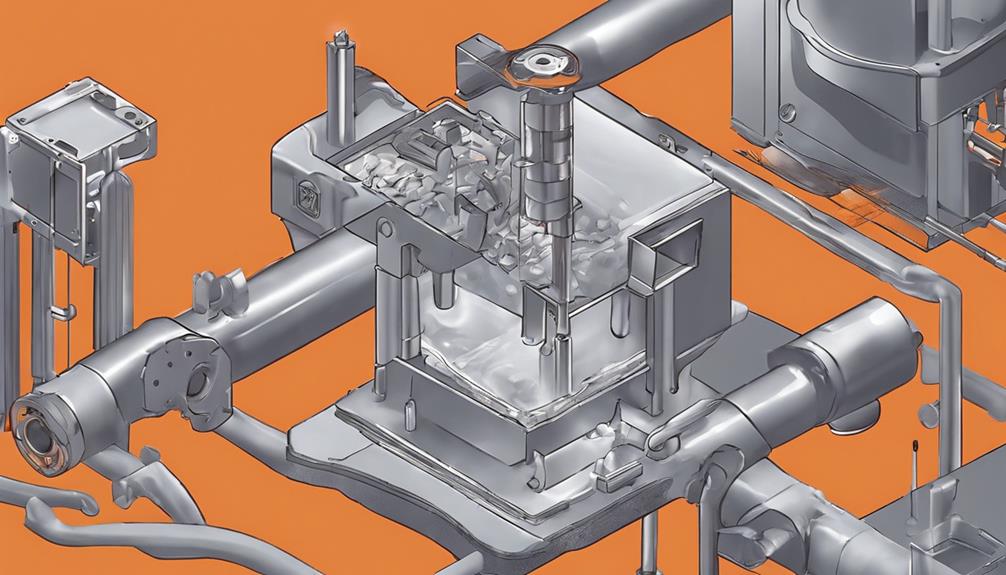
Extrusion molding, a fundamental process in plastic manufacturing, involves the continuous shaping of molten plastic into various forms such as films, sheets, filaments, and profiles. It is a widely used method for the continuous production of items like plastic pipes, tubing, and weather stripping. The process entails pushing melted plastic material through a die, which imparts the desired cross-sectional shape to the product.
Below is a table highlighting key aspects of extrusion molding:
| Aspect | Description | Example |
|---|---|---|
| Process Efficiency | Offers high efficiency in producing long plastic parts with a uniform cross-section. | Continuous production of plastic pipes |
| Types of Extruders | Different types like single screw and twin-screw extruders cater to various material and production requirements. | Single screw for films, twin-screw for profiles |
| Common Applications | Creating plastic pipes, tubing, and weather stripping. | Manufacturing of plastic profiles |
Extrusion molding is favored for its ability to create products with consistent quality and dimensions, making it a valuable technique in the plastics industry.
Thermoforming
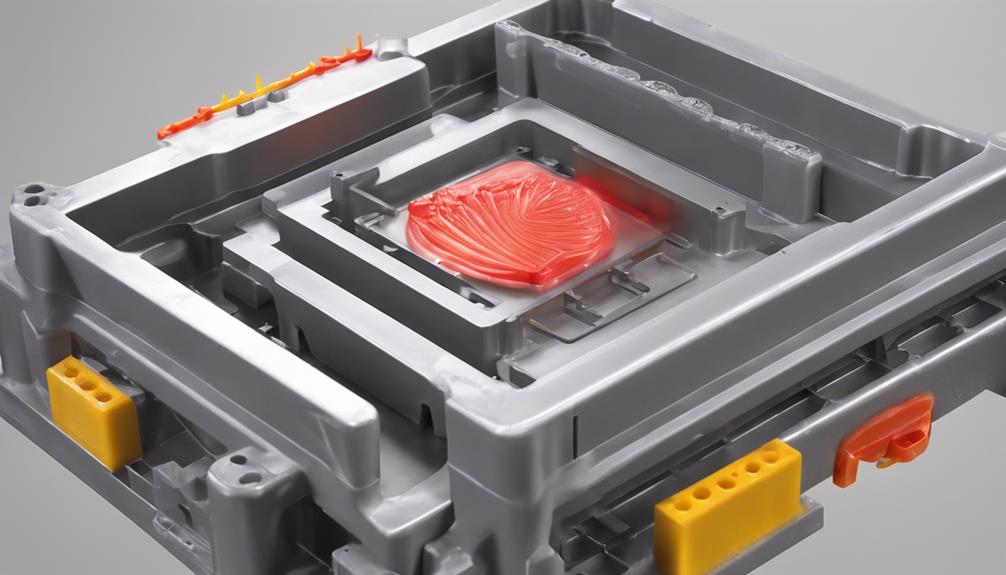
Thermoforming, a widely employed plastic manufacturing technique, involves the process of heating a sheet of plastic material and shaping it into a specific form using a mold. This method is particularly suitable for producing large, shallow parts with uniform wall thickness.
Common types of thermoforming include:
- Vacuum Forming: Utilizes vacuum pressure to shape the heated plastic sheet over a mold, ideal for simple shapes and low-volume production.
- Pressure Forming: Applies additional pressure during the forming process, resulting in parts with more intricate details and sharper edges.
- Twin-Sheet Forming: Involves two separate sheets of plastic heated and formed simultaneously then fused together to create hollow parts or components with varying properties.
Thermoforming allows for the creation of intricate designs and textures on plastic surfaces, enhancing both visual appeal and functionality. Widely used in various industries such as food packaging, automotive, medical, and consumer goods, thermoforming stands out for its versatility and efficiency in producing a wide range of products.
Rotational Molding
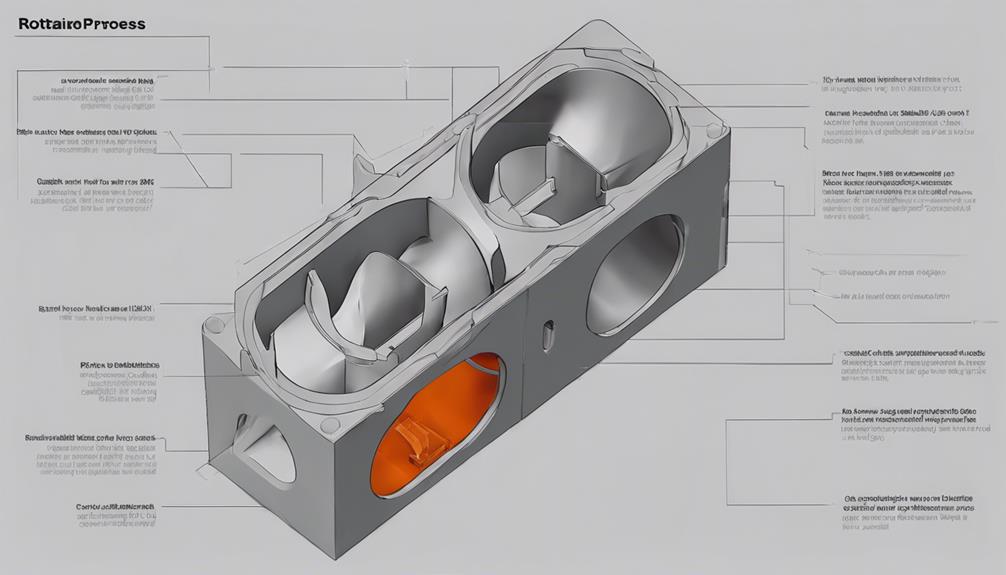
Rotational molding, also known as rotomolding, is a manufacturing process that involves heating and rotating a mold filled with plastic material to create hollow parts.
This method offers several advantages, including the ability to produce complex shapes with consistent wall thickness and minimal waste generation.
Understanding the basics and benefits of rotational molding is essential in exploring its applications and advantages in various industries.
Rotational Molding Basics
Utilizing high temperatures and rotational movement, the process of rotational molding is employed to create large, hollow containers with consistent wall thickness. This method offers design flexibility for intricate shapes and structures, reducing material waste greatly. Ideal for manufacturing tanks, playground equipment, and storage containers, rotational molding stands out for its cost-effectiveness and sturdy final products.
Here are three reasons why rotational molding basics are important in the manufacturing industry:
- Provides the ability to create complex shapes seamlessly.
- Guarantees uniform wall thickness in hollow containers.
- Offers a cost-effective solution for producing durable products.
Advantages of Rotomolding
An essential aspect of rotational molding lies in its capacity to provide unparalleled design flexibility and consistent structural integrity in the production of large, hollow plastic components. Rotomolding, also known as rotational molding, guarantees that parts have uniform wall thickness, reducing the risk of weak points or defects.
This process is environmentally friendly since it generates minimal waste and allows for the recycling of excess materials, contributing to sustainable manufacturing practices. The cost-effectiveness of rotational molding makes it ideal for creating complex shapes in items like tanks and containers.
Despite being a slower method compared to other molding processes, rotational molding produces durable, high-quality plastic products suitable for a wide range of industries.
Compression Molding
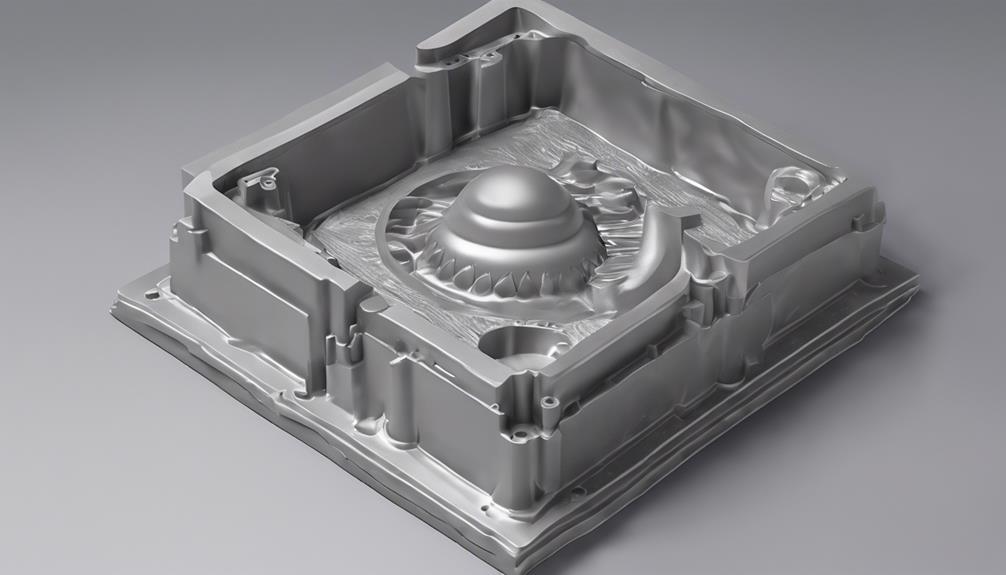
Compression molding, a molding process that utilizes heat and pressure to shape materials within a mold cavity, is a versatile technique renowned for its ability to produce complex parts with varying thickness. This method is commonly used for manufacturing a wide range of products, including automotive parts, electrical components, and appliance parts.
- Precision: By subjecting the material to both heat and pressure, compression molding guarantees precise shaping of intricate and detailed parts, making it ideal for complex components.
- Durability: With the ability to work with materials like thermoset plastics, rubber, and composites, compression molding produces durable parts that can withstand harsh conditions, ensuring longevity and reliability.
- Cost-Effectiveness: Offering a cost-effective production process, compression molding delivers high-quality components with consistent properties, making it a preferred choice for industries seeking efficient manufacturing solutions.
Frequently Asked Questions
What Are the Different Injection Molding Process?
There are several distinct injection molding processes, including:
- Plastic injection molding
- Rubber injection molding
- Metal injection molding
- Gas-assisted injection molding
- Reaction injection molding
These techniques cater to different material requirements and production needs, offering versatility and efficiency in creating various components.
Each process has specific advantages and applications, tailored to meet diverse industry requirements for producing high-quality parts efficiently.
What Are the 4 Stages of Injection Molding?
In injection molding, the 4 stages are clamping, injection, cooling, and ejection.
Clamping maintains pressure on the mold during injection.
Injection involves melting and injecting the material into the mold.
Cooling allows the material to solidify, taking the mold's shape.
Ejection then removes the formed part for the next cycle.
These sequential stages are essential in ensuring the precise and efficient production of molded parts in various industries.
What Are the 5 Steps of Injection Molding?
The 5 steps of injection molding are:
- Clamping secures the mold during material injection.
- Injection involves introducing molten material into the mold under pressure.
- During dwelling, the material cools and solidifies.
- Cooling helps the part to harden before ejection from the mold.
- Ejection is the final step where the finished part is removed from the mold for further processing.
What Are the Key Processes for Injection Molding?
Key processes for injection molding include:
- Hot runner molding for material control
- Cold runner molding for cost efficiency
- Gas-assisted molding for hollow sections
- Reaction injection molding for large parts from reactive polymers
- Water-assisted molding to reduce material usage
Multi-material molding allows for different materials in a single cycle. Techniques like insert molding encapsulate components, while over-molding improves part properties. Specialized techniques tailor injection molding to diverse production needs.
Conclusion
To sum up, the various injection molding processes discussed offer a wide range of options for manufacturing products with different materials and properties. Each process has its own advantages and applications, providing manufacturers with flexibility and efficiency in production.
By understanding the differences and capabilities of these processes, companies can make informed decisions on which method best suits their needs and requirements.
The exploration of injection molding processes reveals the intricate and precise nature of modern manufacturing techniques.
